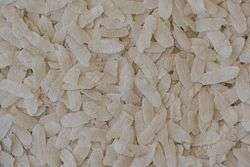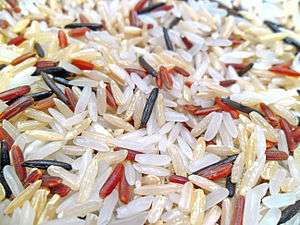Flattened rice
|
Uncooked Flattened rice flakes | |
| Alternative names | Aval, Avalakki, Chiura, Poha, beaten rice |
|---|---|
| Main ingredients | Dehusked rice |
|
| |
Flattened rice (also called beaten rice) is a dehusked rice which is flattened into flat light dry flakes.They are most famously known as "Pohe" in the Malwa region, where they are considered to have originated. These flakes of rice swell when added to liquid, whether hot or cold, as they absorb water, milk or any other liquids. The thicknesses of these flakes vary between almost translucently thin (the more expensive varieties) to nearly four times thicker than a normal rice grain.
This easily digestible form of raw rice is very popular across India, Nepal and Bangladesh, and is normally used to prepare snacks or light and easy fast food in a variety of Indian cuisine styles, some even for long-term consumption of a week or more. It is known by a variety of names: Pauaa/Paunva (પૌંઆ) in Gujarati, "Poya" in Rajasthani, Chuda in Oriya, Atukulu in Telugu (అటుకులు), Aval in Tamil(அவல்) and Malayalam(അവൽ), Chiura in parts of Bihar and Jharkhand, Chira in Bengali (চিঁড়া) and Assamese, Chiura (चिउरा) in Maithili, Nepali, Bhojpuri and Chhattisgarhi, Poha[1] or Pauwa[2] in Hindi, Baji in Newari, Pohe in Marathi, Phovu in Konkani, Avalakki (ಅವಲಕ್ಕಿ) in Kannada,.[3]
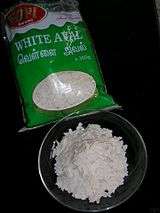

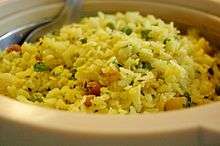
Flattened rice can be eaten raw by immersing it in plain water or milk, with salt and sugar to taste, or lightly fried in oil with nuts, raisins, cardamoms, and other spices. The lightly fried variety is a standard breakfast in Malwa region (surrounding Ujjain and Indore) of Madhya Pradesh. It can be reconstituted with hot water to make a porridge or paste, depending on the proportion of water added. In villages, particularly in Chhattisgarh, flattened rice is also eaten raw by mixing with jaggery.
In Maharashtra, pohe is cooked with lightly fried mustard seeds, turmeric, green chilli, finely chopped onions and then moistened pohe is added to the spicy mix and steamed for a few minutes.
Flattened rice can be viewed as a convenience food and is very similar to bread in usage.
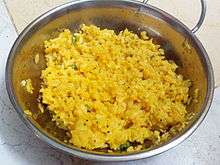
Dishes made from beaten rice
| Wikibooks Cookbook has a recipe/module on |
- Aval Nanachathu (അവൽ നനച്ചത്) also called Aval Kuthirthathu (അവൽ കുതിർത്തത്) (Kerala): Beaten rice is mixed with milk, sugar, ground coconut and banana pieces. Peanuts or cashews may be used.
- Aval Vilayichathu (അവൽ വിളയിച്ചത്) (Kerala): Beaten rice fried in ghee and mixed with jaggery, dal, cashews, peanuts and ground coconut.
- Dahi Chiuraa (Nepali): Beaten rice mixed with ripe banana, yogurt, and sugar. Although an "anytime" snack, it is also traditionally eaten by farmers during the rice plantation season in Nepal.
- Dhau Baji (Newar): Beaten rice is dry roasted in a pan, then mixed with yogurt and sugar.[4]
- Chindé'r pulao: A snack prepared by immersing the rice flakes in cold water, drying them, and then preparing pilaf-style with nuts, raisins, black pepper, green chillies, and salt and sugar to taste. This is very popular as a breakfast or evening dish in families, and may not be available in any stores or restaurants.
- Chindé bheja: Flakes are immersed in a bowl of water and flavoured with lime juice, salt, sugar, and black pepper.
- Chuda kadali chakata (Odisha): Washed beaten rice is mixed with milk, mashed ripe bananas, sugar or jaggery. A traditional breakfast meal eaten by Oriyas.
- Bajeel Ogarne or Avalakki Oggrane (ಅವಲಕ್ಕಿ ಒಗ್ಗರಣೆ - Karnataka): Beaten rice is seasoned with curry leaves, mustard seeds, gram, peanuts, oil, and red chillies. Optional add-ins like grated coconut, onion and coriander leaves are also permissible. Served hot.
- Gojju avalakki or Huli avalakki (Karnataka)
- Beaten rice with curds: Beaten rice is soaked in water and then sieved. Curd is added with table salt, and eaten with mango or lemon pickle.
- Kanda Pohe: Small pieces of boiled potato, onion, mustard seeds, turmeric and red chilli are seasoned and mixed with soaked and sieved beaten rice, and served hot.
- Dadpe Pohe: Thin or medium-sized beaten rice is mixed with fresh coconut, grated green mangoes, chilli powder, and coriander. Then it is seasoned with salt and a fried mixture of peanut oil, mustard seeds, turmeric, and finely chopped onions.
- Dahi Chuda: Beaten rice is cleaned with water to make it slightly soft, then yogurt and sugar is added. This way of eating flattened rice is popular in Assam, Bihar and Orissa, and it is eaten as the first meal during festival of Magh Bihu in Assam and Makar Sankranti.
- Egg Pulau (Nepali): Spicy omelette preparation is whisked with raw and dry flattened rice and cooked in a pan in a similar way to an omelette. The almost-cooked egg pulau is mashed and left to cook, covered, until it turns red in colour.
- Poha Jalebi: This is the most famous breakfast across the Malwa region of Madhya Pradesh especially in Sagar, Indore, Ujjain, Ratlam, Mandsaur, Bhopal, Hoshangabad.
- Kharbujache Pohe:[5] Beaten rice with muskmelon.
- Ful (egg) Chiura (Nepali): Common in Kathmandu households, flattened rice is fried in oil in a deep pan and salt is added. When the flattened rice turns golden/red, an egg is poached on top of it and covered with the rice until it has cooked.
- Theek (spicy) Phovu with coconut and hing (Konkani) : This is the most delicious konkani recipe made with beaten rice (phovu) by adding a blended mixture of coconut flakes, hing (asafoetida), salt, green chillies and sugar to the softened phovu with 2 teaspoon of coconut oil.
Flattened rice is made by Cambodians during Ak Am Bok (around the fourth week of November) and is eaten with bandanna fruit.
In popular culture
In the Marathi movie Sanai Choughade, there is a song about Kande Pohe, also called 'Kande Pohe'.[6]
References
- ↑ Raghunandana, K. "Avalakki Oggrane'it contains 100 g of iron". Retrieved 2009-02-09.
- ↑ "The Vocabulary of Indian Food". Retrieved 2009-02-09.
- ↑ Raghunandana, K. "Avalakki Oggrane'". Retrieved 2009-02-09.
- ↑ "magazineoftheworld.com". magazineoftheworld.com. Retrieved 2013-12-15.
- ↑ "Yes, Muskmelon Pohe". Retrieved 2011-12-18.
- ↑ Sanai Choughade
